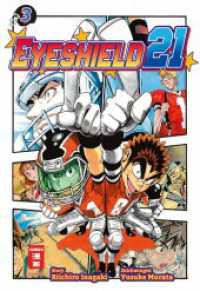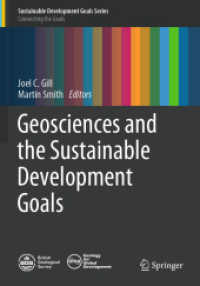- ホーム
- > 洋書
- > 英文書
- > History / World
Full Description
Nō and kyōgen theatre are among the longest continuously staged dramatic forms in the world and are deeply connected to Japanese arts, culture, society, and history. This richly illustrated two-volume set brings together the important elements of these traditions to offer new insights, with contributions by Japanese and non-Japanese experts from a broad range of disciplines. It represents the most ambitious and exhaustive exploration of nō and kyōgen to date, and is an invaluable resource for both scholars and enthusiasts. (This is volume 2 out of 2). For Volume 1 see: brill.com/edcollbook/title/62128.
Contents
Volume 2
Preface
Notes to Readers
List of Illustrations
Notes on Contributors
6 Treatises and Criticism
Edited by Tamamura Kyō and Shelley Fenno Quinn
6.1 Introduction (Tamamura Kyō)
6.2 Zeami's Treatises: an Overview (Shelley Fenno Quinn)
6.3 Zeami as Philosopher: Who Makes the Flower Bloom? (Tamamura Kyō)
6.4 Zenchiku's Treatises and Criticism (Takahashi Yūsuke)
6.5 Konparu Zenpō's Treatises and Criticism (Ikai Takamitsu)
6.6 Nō Treatises from the Late Muromachi to Edo Periods (Miyamoto Keizō)
6.7 Modern Theories of Nō (Yokoyama Tarō)
References
7 Material Culture of Nō and Kyōgen
Edited by Eike Grossmann
7.1 Introduction (Eike Grossmann)
7.2 The Production of Costumes, Masks, and Fans (Monica Bethe)
7.3 The Transmission of Masks: Carvers and Their Lineages (Adam Zollinger)
7.4 Instruments: Artistic Value and Development of Their Forms (Takakuwa Izumi)
7.5 Performance Spaces: History and Materiality of the Nō Stage (Miyamoto Keizō)
7.6 Tsuke: Notes on Movements, Gestures, Music, and Stage Properties (Fukazawa Nozomi, Nakatsuka Yukiko, and Yamanaka Reiko)
7.7 Utaibon for Amateurs and Connoisseurs (Ikai Takamitsu)
7.8 Nō and Kyōgen Illustrations (Monica Bethe)
7.9 Nō and Kyōgen Prints and Paintings in Modern Japan (Richard Smethurst)
7.10 Nō Culture in Everyday Life: Koutaibon, Sugoroku, Karuta, Yubimen, Netsuke, and Nō Ningyō (Eike Grossmann)
References
8 Reception
Edited by Diego Pellecchia and Yokoyama Tarō
8.1 Introduction (Yokoyama Tarō)
8.2 Reception of Nō in the Late Nineteenth and Early Twentieth Centuries (Diego Pellecchia)
8.3 Nō and Modernism (Diego Pellecchia and Takeuchi Akiko)
8.4 Nōgaku and Film (Kodama Ryūichi)
8.5 Nō and Contemporary Theatre Abroad and in Japan (Diego Pellecchia and Yokoyama Tarō)
8.6 Why Not Nō? (Reginald Jackson and Yokoyama Tarō)
8.7 Nōgaku and Kabuki (Kodama Ryūichi)
References
9 Kyōgen
Edited by Monica Bethe
9.1 Introduction (Monica Bethe)
9.2 Plays, Plots, and Role Types (Jonah Salz)
9.3 Dramaturgy (Jonah Salz)
9.4 Costumes and Masks (Monica Bethe)
9.5 Organization, Training, and Creativity (Jonah Salz)
9.6 History (Monica Bethe)
9.7 The Evolution of Texts (Taguchi Kazuo)
9.8 Discourses (Taguchi Kazuo)
9.9 Sagi kyōgen (Alex Rogals)
9.10 Women in Kyōgen (Barbara Geilhorn)
9.11 Inspiration, Fusion, and Form: Kyōgen outside Japan (Ondřej Hýbl)
References
10 Research Overview
Edited by Yamanaka Reiko, Tom Hare, and Michael Watson
10.1 Introduction (Yamanaka Reiko)
10.2 Research into Nō before the Meiji Period (Yamanaka Reiko)
10.3 Nō Scholarship from the Meiji, Taishō, and Shōwa Periods to World War II (Tom Hare and Yamanaka Reiko)
10.4 Postwar Studies of Nō (Yamanaka Reiko)
10.5 The History of Nō Research and Translations in Western Languages: French, Italian, German, and English (Diego Pellecchia, Eike Grossmann, and Tom Hare)
References
11 Appendices
11.1 Finding List for Nō Texts (Michael Watson)
11.2 Summaries of Nō Plays (Nakatsuka Yukiko and Michael Watson, with contributions by Fukazawa Nozomi, Inoue Megumi, Hana Lethen, Pia Schmitt, Patrick Schwemmer, and Tomiyama Takahiro)
11.3 Summaries of Kyōgen Plays (Monica Bethe)
References (Michael Watson)
Glossary
Index








